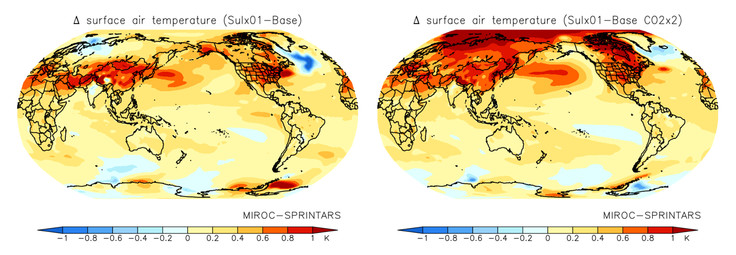The greenhouse effect may be impacted by sulfate aerosols, often produced by fossil fuels and wood. While fossil fuels are going out of fashion in Europe those countries have increasingly been importing and burning wood pellets for fuel, where thanks to Paris agreement rules they wrote they are charging the climate emissions to the countries where the wood is purchased.
They can claim whatever they want about reducing emissions in political documents but pollution doesn't lie. However, models are basically just elaborate video games so they can help with possible outcomes but they can't account for everything in the real world. Ask any economist and they can tell you the same thing a soldier does; simulations are great until the real world happens. As the saying goes, everyone believes the data except the collector, and no one believes the model except the modeler.

Simulations using MIROC-SPRINTARS predict annual mean distribution of changes in surface air temperature following reduction of SO₂ emissions from fuel sources to 10% of the current level under present (left) and doubled (right) CO₂ concentrations. Decreasing sulfate aerosols from human activity at high CO₂ concentrations results in enhanced temperature increases, especially in the mid-to-high latitudes of the Northern Hemisphere. Credit: https://doi.org/10.1038/s41598-020-78805-1
So let's not get too confident that reducing sulfate aerosols can be reduced and the problem goes away, because the new simulation uses two other simulations, SPRINTARS (Spectral Radiation-Transport Model for Aerosol Species) of Kyushu University and MIROC (Model for Interdisciplinary Research on Climate) produced by the University of Tokyo and a consortium. SPRINTARS is used for those PM2.5 maps that became common as real pollution (PM10) disappeared while MIROC is an early global warming modeler.
Using both, the authors estimate that if Sulfur dioxide (SO2) were reduced, climate change would be mitigated. Without question, sulfur oxides - caused by everything from volcanoes to trains - can cause difficulty for people with asthma, but too often, like with traces of chemicals, the presence of a pathogen is conflated with pathology from it when instead 'the dose makes the poison.' Methane, for example, was manufactured as a new boogeyman after natural gas began to drive out coal in the U.S. - activists had been endorsing natural gas for 50 years prior to that. Yet they leave out that the half-life of methane is so short at real-world levels it is a minor worry. We would have to increase our energy consumption worldwide by 500 percent and have all of it provided by natural gas for methane to come close to the impact of CO2.
The paper can't really claim that the sulfate aerosols will make the difference alone so they instead argue they are atmospheric adjuvants - they might reduce cloud cover which means more sunlight which means greater warming.
So reducing sulfate aerosols gives us time to bridge to more natural gas or nuclear, or even solar once it becomes viable. And it is a lot more ethical, and therefore achievable, than denying poor countries World Bank funding unless they agree to build solar panels everyone knows will not work. Which is what we did just a few short years ago and has done nothing but keep the 2,000,000,000 people still using wood and dung for fuel doing so.





Comments